Protecting Student Mental Health on College Campuses
The aim of JED Campus is to ensure that schools have comprehensive systems in place in order to prioritize student mental health and create positive systemic change in the campus community.
Our evaluation of 56 schools that completed the JED Campus program from 2014 to 2020 shows evidence of improvement across program, policy, and systems change indicators that support and protect student mental health, across all domains in the Comprehensive Approach to Mental Health Promotion and Suicide Prevention for Colleges and Universities.
Download the full JED Campus Impact Report.
Highlights from the 2020 JED Campus Impact Report
Strategic Planning
76% of JED Campuses view student emotional health as a campus-wide issue (vs. 57% at start of JED Campus) requiring involvement of multiple campus departments and stakeholders.
Before and after JED Campus

Campus Spotlight: Binghamton University
“During the time of participation in JED Campus, Binghamton University has been moving towards viewing mental health as a campus-wide issue. Health and Counseling, which includes the Counseling Center, carries significant responsibility for emotional well-being on campus, however a focus on mental health is becoming more integrated throughout Student Affairs and the broader campus and seen as a responsibility of all stakeholders. This was clearly evident at a recent meeting of campus leaders, during a discussion of end of the semester student stress. Various groups from all Divisions shared initiatives they were engaged in to support emotional/mental well-being of students as well as faculty/staff. The Division of Studratent Affairs, the Dean of Students, Health Promotion and Prevention Services, and Services for Students with Disabilities are departments outside of Counseling involved in supporting the mental health of students.”
Strategic Planning: Why it Matters
Strategic Planning is an overarching critical step encompassing all seven domains, to ensure that sustainable change is successfully implemented in a higher education setting. Lessons learned from the first few years of JED Campus highlighted the need for the strategic planning process, particularly for schools to create a team of administrators, faculty, staff, and students from across departments at the institution, to oversee the effort and ensure institutional support to implement the recommendations provided by the program.
Strategic Planning: Results
Upon completion of JED Campus, more schools have a strategic plan in place for student emotional health (65% versus 26% at baseline), as well as task forces devoted to improving student emotional health, with participation from campus leadership offices (95% versus 64% at baseline). Creating (or forming) a collaborative mental health leadership team of administrators, faculty, and students on campuses, including participation from the school’s senior leadership, ensures that there is adequate institutional support to implement and sustain the recommendations that are given.
Schools are also more likely to report that student emotional health is viewed as a campus-wide issue that lives beyond the walls of their counseling center, involving significant input from multiple campus departments and stakeholders (76% versus 57% at baseline).
Develop Life Skills
91% of JED Campuses have campaigns/programs that educate students about the link between good physical health, emotional health and academic success – up from 80% at start of JED Campus.
Before and After JED Campus
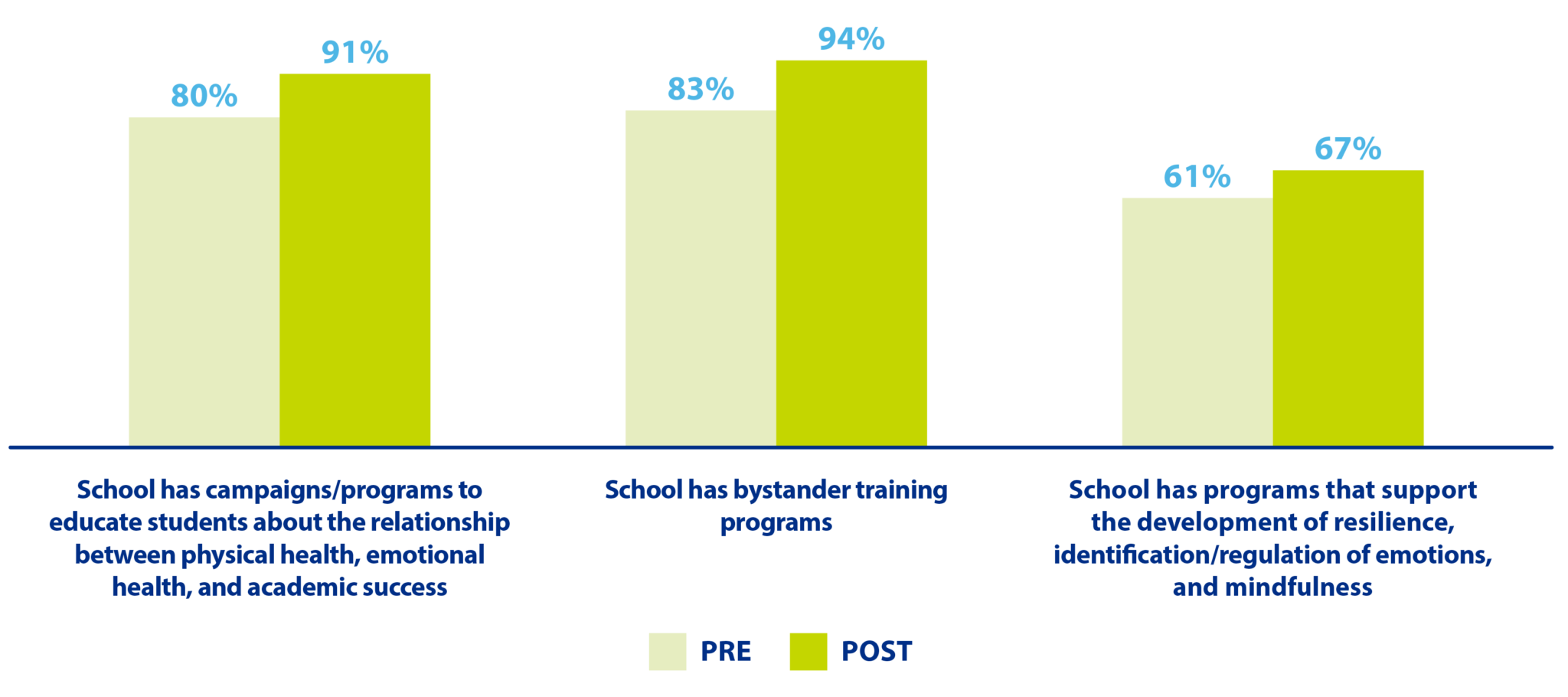
Campus Spotlight: Santa Clara
“We know there is a strong relationship between physical and emotional health and academic success. To support a balanced, healthy lifestyle, beginning in the Fall, we made all fitness center classes free to students. Over 700 students used their free fitness passes 1,843 times in the Fall quarter, a 92% increase in use over last Fall.”
Develop Life Skills: Why it Matters
Research has shown that promoting students’ social and emotional life skills can support mental health and academic achievement. Some of the life skills that are important to a student’s well-being include managing friendships and relationships, exploring identities and values, and having productive approaches to problem solving, decision making, identifying and managing emotions, healthy living, and finding life purpose and meaning.
Develop Life Skills: Results
While many schools reported having several life skills programs in place at the start of JED Campus, these programs have continued to develop and expand their reach over time in JED Campus – particularly programs that address links between students’ physical health, emotional health, and academic success (91% versus 80% at baseline), programs that teach bystander training (94% versus 83% at baseline), and programs that support resilience, identification and regulation of emotions, and mindfulness (67% versus 61% at baseline). One of the goals of JED Campus is to encourage schools to be more intentional and strategic about the timing, coordination, and implementation of these programs.
Promote Social Connectedness
100% of JED Campuses have programs that promote tolerance and inclusiveness on campuses.
Before and After JED Campus
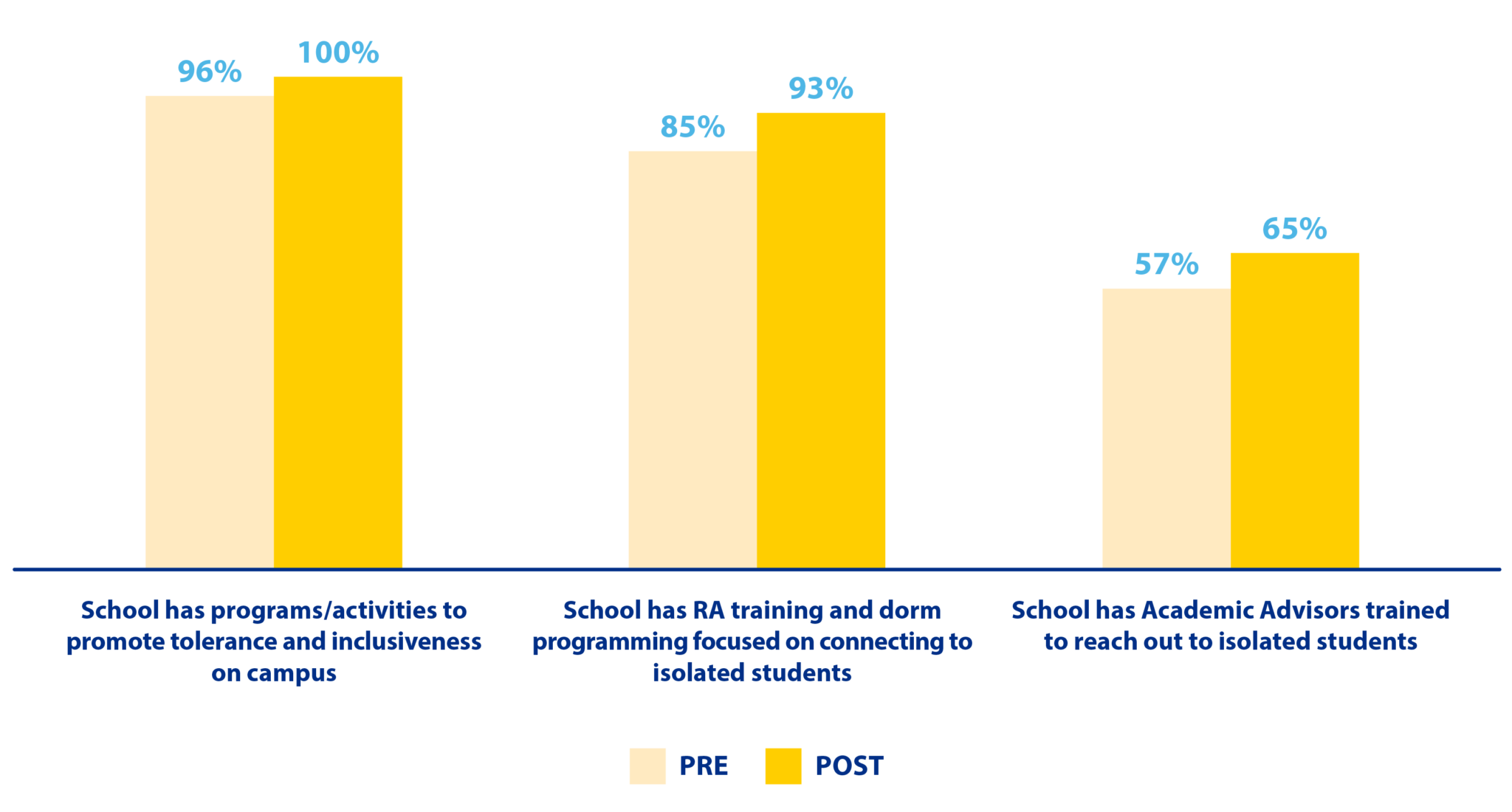
Campus Spotlight: Kent State University
“Kent State’s regional campuses created targeted outreach for student populations based on the culture of their campuses. This includes LGBTQ+ students, non-traditional students that are parents, veterans, and students that have been impacted by the opioid epidemic in the state. Increased attention is now being paid to supporting international students as well, including programming about what mental wellness is at their temporary housing during evening hours. Mental health services offices also increased their visibility and outreach to students including non-clinical programs such as Coloring for Calmness and Stressbuster Week. The Dogs on Campus program, which brings teams of therapy dogs to campus for students, is an unexpected avenue of student connectedness. Students often end up talking to each other or in small groups around a dog about their own pets and make a connection with one another.”
Read the Kent State University Case Study
Dave’s Story
Mike’s Story
Promote Social Connectedness: Why it Matters
Research has shown that loneliness and isolation are significant risk factors for mental health problems and/or suicidal behavior. Therefore, supportive social relationships and feeling connected to campus, family, and friends are protective factors that can help lower risk of suicide and other mental health challenges.
Promote Social Connectedness: Results
Upon completion of JED Campus, 100% of schools have programs or activities to promote tolerance and inclusiveness on campus (versus 96% at baseline). Among JED Campus schools that had systems/strategies in place to help to identify and support disconnected or isolated students, more schools engage in Resident Advisor training and dorm programming focused on connecting to isolated students (93% versus 85% at baseline) and Academic Advisors who are trained to reach out to disconnected or isolated students (65% versus 57% at baseline).
Identify Students at Risk
81% of JED Campuses screen students for depression, anxiety, and suicidal ideation at campus health centers – up from 59% at start of JED Campus.
Before and After JED Campus

Campus Spotlight: Fort Hays
“Our campus initiative resulting from JED Campus created, implemented or modified institutional policies and practices to improve the university’s environment and enhance our mental health and student adjustment services. For instance, the committee looked for ways to identify risks and begin dealing with them early. The health form that incoming students complete for the Campus Health Center now includes questions about mental health and alcohol and drug histories. Students who self-identify as having mild or moderate mental health issues get an email outlining services available on campus, and campus care providers follow that up by helping students develop self-care plans.”
Identify Students at Risk: Why it Matters
Early intervention is critical for preventing suicide. Research shows that a vast majority of students who die by suicide did not receive mental health treatment. Identifying students at risk for mental health problems and/or suicidal behavior is a central pillar of any robust campus suicide prevention and mental health promotion initiative. Preparing “gatekeepers”—those who interact with students the most such as residence hall staff, academic advisors, faculty and even fellow students to both detect suicide risk and to promote emotional health awareness is vital for these people to be able to recognize and refer a student who might be in distress.
Identify Students at Risk: Results
More schools are identifying students at risk by 1) implementing standardized screenings for substance misuse, common mental health problems, and suicidal ideation by health service clinicians at primary care visits (81% versus 59% at baseline); 2) offering more gatekeeper training programs that train faculty and staff to identify students at-risk and refer them to counseling services (95% versus 82% at baseline); and 3) making screening tools more readily available, which help students better identify their mental health symptoms in order to reach out for counseling services (96% versus 76%).
Increase Help-Seeking Behavior
JED Campuses have increased their campaigns/programs that destigmatize mental health – from 76% to 87% of schools.
Before and After JED Campus
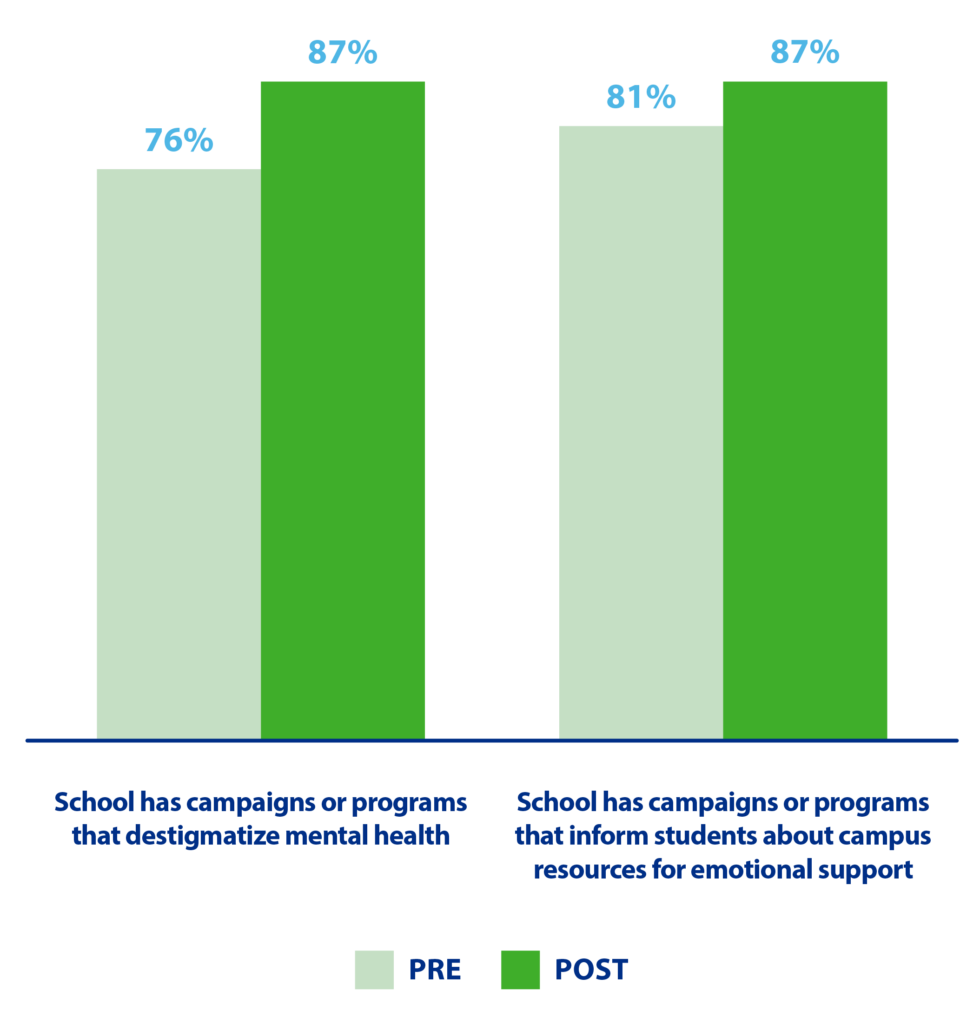
Increase Help-Seeking Behavior: Why it Matters
Students are more likely to reach out to their friends or family about distressing feelings than mental health professionals. Many students who need help may be reluctant or unsure of how to seek it out. Obstacles to help-seeking include lack of awareness of mental health services, skepticism about the effectiveness of treatment, prejudices associated with mental illness, and uncertainty about costs or insurance coverage. Campuses should engage in a variety of activities designed to address these and other locally identified barriers to increase the likelihood that a student in need will seek help.
Increase Help-Seeking Behavior: Results
More schools are implementing campaigns on campus to promote help-seeking behavior (87% versus 76% at baseline) and campaigns to inform students about campus resources for emotional support (87% versus 81% at baseline).
Provide Mental Health and Substance Misuse Services
JED Campus provides greater support for college counseling centers. Upon completion of JED Campus, 89% of schools have offered after-hour counseling services (up from 65%) and 43% have achieved ideal staff to student ratios (up from 30%).
Before and After JED Campus
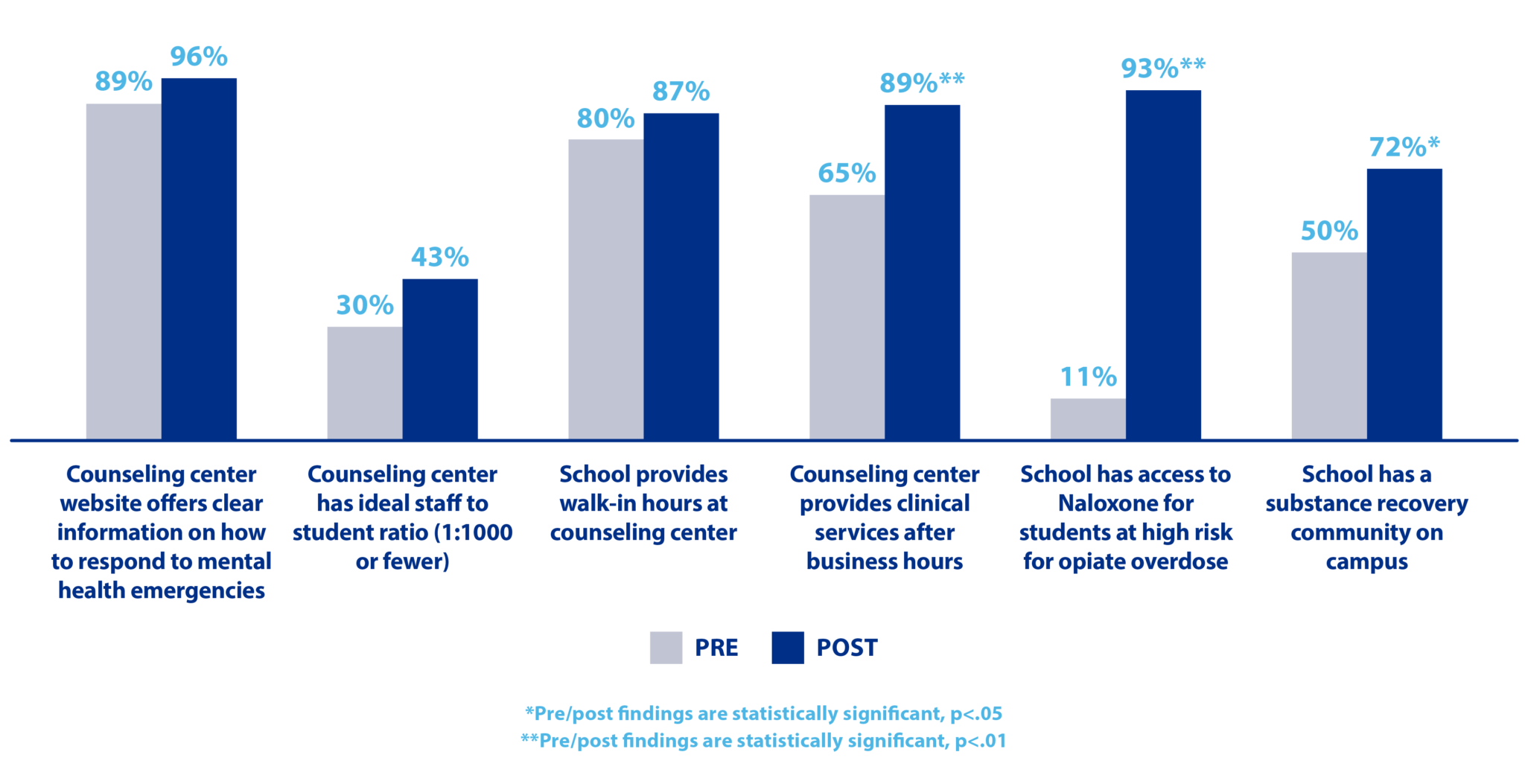
Campus Spotlight: University of Minnesota
“As a result of our partnership with the JED Campus program, every department across campus has a designated mental health liaison that provides students with easier access to support in places on campus where they feel most comfortable. Additionally, students who present to the counseling center are now seen within 24-48 hours in order to more quickly service students who present with urgent concerns.”
Provide Mental Health and Substance Misuse Services: Why it Matters
Many students who need mental health care do not receive it. It is essential to offer accessible, consistent, and high-quality mental health services to students, especially those who are at high-risk of suicide. To make mental health and substance misuse care more comprehensive, approaches to care should include adequate staffing levels and staff diversity reflective of the student population, flexibility in treatment approaches, and clinic hours that are reflective of student schedules. The length of treatment is often limited in college clinics. Therefore, it is important that campus mental health services can assist students in finding off-campus resources that can provide long-term care if needed.
Provide Mental Health and Substance Misuse Services: Results
Improvements are being made by many schools to ensure that counseling centers are providing more support, including 1) providing clear information on counseling center webpages on how to respond to mental health emergencies (97% vs. 90% at baseline), 2) improving staff to student ratios (43% have “ideal” staff to student ratios at 1:1000, versus 30% at baseline), 3) adding clinical services offered outside of regular center hours (89% versus 65% at baseline), and 4) providing walk-in hours (87% versus 80% at baseline).
More campuses have access to Naloxone for students deemed high-risk of opiate overdose (93% versus 11% at baseline). There is also an increase in the number of schools that have a recovery community on campus, to support students with substance misuse challenges (72% versus 50% at baseline).
Follow Crisis Management Procedure
98% of JED Campus alumni have 24/7 crisis lines available for students in need of immediate help and have Behavioral Intervention Teams in place to track and protect students of concern on campuses.
Before and After JED Campus
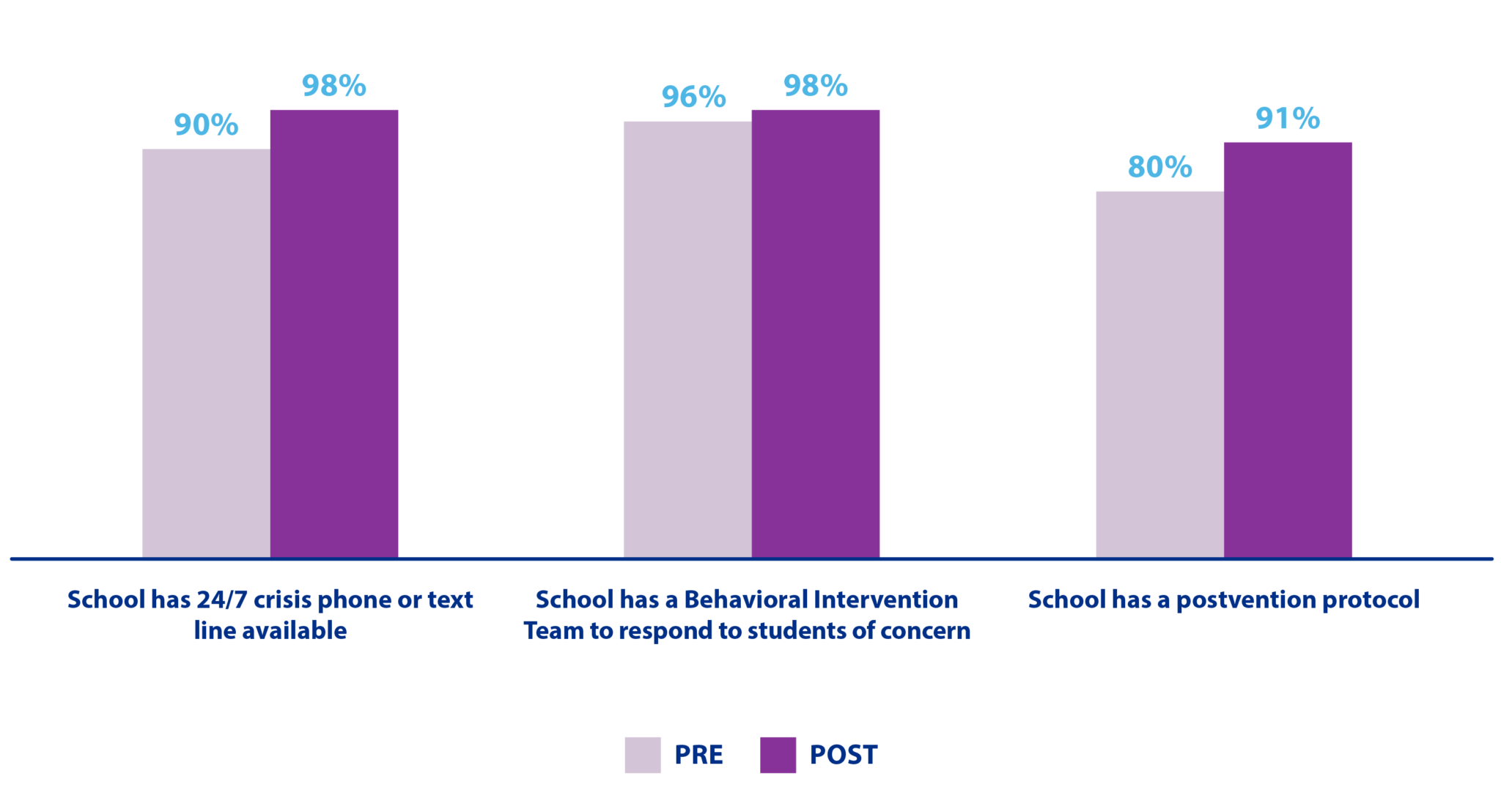
Campus Spotlight: University of Pennsylvania
“As a result of our partnership with the JED Campus program, we have implemented a case management system, enhanced our triage and referral systems, decreased wait times for first appointments, and increased staff to more quickly respond to and support our students. As a result of our partnership with the JED Campus program, one of our students created an app that provides students with on-campus mental health resources 24/7. As a result of our partnership with the JED Campus program, we have instituted a 24 hour on call service for students to access care in the event of an emergency.”
Arthur’s Story
Follow Crisis Management Procedure: Why it Matters
Crisis management consists of having campus-wide emergency and postvention protocols, policies relevant to students experiencing mental health or substance-related crises, and support and clinical services for students experiencing an acute crisis. The campus should have access to a well-publicized 24/7 crisis phone and/or chat line either through campus resources or local/national services. There should be a process in place to share information (as legally appropriate) between local emergency rooms and school health and/or counseling services.
Follow Crisis Management Procedure: Results
Nearly all schools (98%) report having a 24/7 crisis line, for college students in emergency situations, up from 90% at baseline. Additionally, nearly all schools (98%) have an “at risk” or “Behavioral Intervention” team on their campus to receive and respond to reports of students of concern (versus 96% at baseline). More schools have a postvention protocol (91% versus 80% at baseline), which puts in place resources and interventions that provide emotional support, crisis intervention, and assistance to those affected by a student death on campus.
Restrict Access to Potentially Lethal Means
JED Campuses are more likely to have recently conducted a campus environmental scan to limit access to potentially lethal means – 70% of schools, up from 27% at start of JED Campus.
Before and After JED Campus

Campus Spotlight: University of California, Davis
“JED has helped us to develop a Campus Action Plan with deliverables that are specifically tailored to our needs and our campus. In efforts to jump start our means restriction process, we’ve identified hot spot areas on campus and will be installing permanent signage with Crisis Text Line information. Our first phase and priority includes all parking structures as data from campus partners (including students, UC Davis Police and the Crisis Response Team) all highlight parking structures as a high-risk, hot spot area for UC Davis. Over the summer, we plan to refine our means restriction instrument to implement and conduct the environmental scan. We use a grassroots approach in building campus relationships in order to build a small team of key partners all who are very interested and eager to help with this scan when the time comes.”
Lisa’s Story
Restrict Access to Potentially Lethal Means: Why it Matters
It has been well established that if the means to self-harm are removed or limited in an environment, it can prevent suicide and even limit accidental deaths. This is called “means restriction.” Limiting students’ access to weapons, poisonous chemicals and rooftops, windows or other high places are all means restriction activities. Each campus should do an environmental scan for potential access to lethal or dangerous means.
Restrict Access to Potentially Lethal Means: Results
As the most empirically supported measure to prevent suicide, it is essential to implement means restriction activities on college campuses. As compared to baseline, more JED Campuses have conducted a yearly campus environmental scan to identify potential access to lethal means (70% versus 27%). Environmental scans require planning and coordination with various campus offices. An improvement of this magnitude shows great promise.
More schools have installed breakaway closet rods in residence halls (20% versus 4% at baseline). And more JED Campuses also have prescription drug collection or return programs on campus (45% versus 29%), to limit accessibility to prescription medication misuse or overdose. These, and other means restriction measures, are critical to ensuring safety to students and preventing suicides on college campuses.
Implementing the Comprehensive Approach at Home
JED’s Comprehensive Approach can be helpful for families and friends looking for ways to support the mental well-being of the young person in their life while a student is at home.
Learn about implementing the Comprehensive Approach at home.


